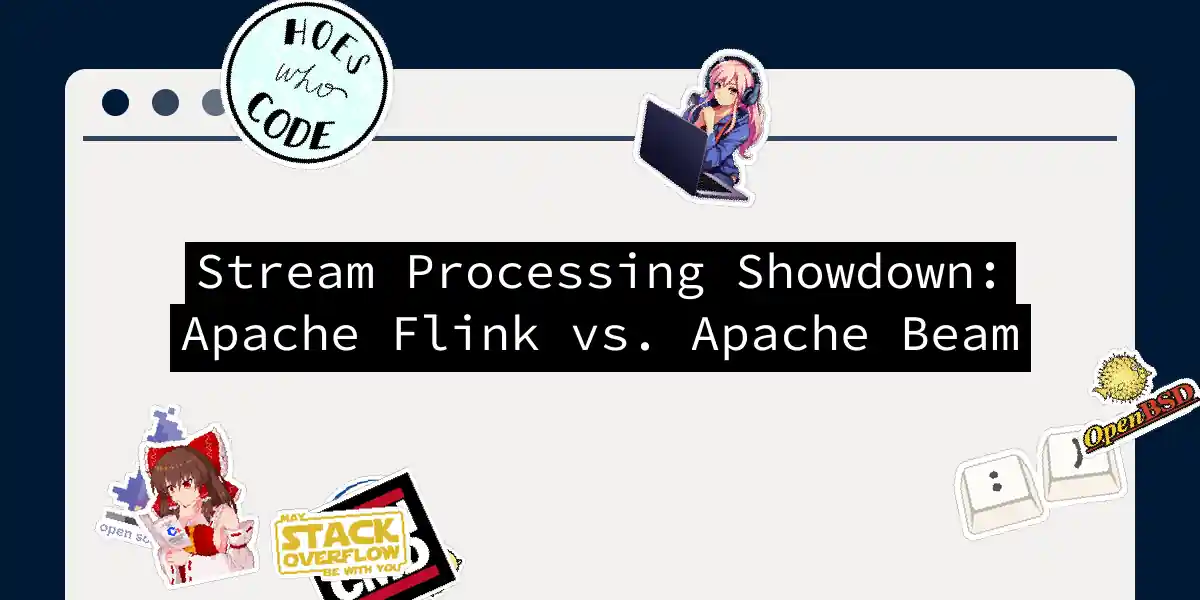The Great Debate: Choosing the Right Stream Processing Champion
Imagine two professional athletes vying for your attention: Flink - the sprinter optimized for raw speed, Beam - the marathon runner with unparalleled endurance. Who deserves your team? Let’s break it down.
Core Philosophies: Flink vs. Beam
The difference between these frameworks can be boiled down to their founding principles:
| Aspect | Apache Flink | Apache Beam |
|---|---|---|
| Origin Story | Built to conquer real-time challenges | Created for universal adaptability |
| Execution | Runtime-optimized, owns its engine | Portable runner, picks its engine |
| Best At | Nanosecond decision-making, tight SLAs | Pipeline pioneering for new engines |
| Flink’s secret weapon? A unified engine for batch AND streaming. | ||
| Beam’s ace? Ability to run “write once, deploy anywhere” across Spark, Flink, Dataflow, etc. |
Architectures: Under the Hood
Let’s visualize how each handles data:
Flink’s strength lies in tight integration between components - think tightrope walkers vs. juggling ringmasters. Beam’s advantage is acting as the “orchestra conductor,” harmonizing diverse execution engines.
Real-World Showdown: Event Joins
Challenge: Join event A (customer action) and B (system response) with potential 6hr gaps.
Flink Approach
Leverage event-time processing for perfect joins:
// Flink Java example with Table API
StreamExecutionEnvironment env = StreamExecutionEnvironment.getExecutionEnvironment();
Table t = env.from("kafka").addSource(...);
// Join logic with event-time semantics
table
.filter("type = 'A'")
.innerJoin(table.filter("type = 'B"), "id")
.writeToSink(...)
Key Trick: Flink’s stateful processing ensures partial bids are stored until matches, even 6hr latecomers.
Beam Approach
Use side inputs for temporal joins:
# Beam Python pipeline
import apache_beam as beam
with beam.Pipeline() as pipeline:
events = pipeline | beam.Create([...]) # Read events
# Save events with timeout
table = events | beam.GroupByKey(lambda x: x['id'])
table | beam.Map(process_split).write(...)
# Function to merge when both types arrive
def process_split(pkey, elements):
a, b = elements if len(elements) == 2 else [None, elements[0]] if
# Custom logic for joining, write to Elasticsearch
Beam’s Power Play: Portable operations across engines - same code runs on Flink, Spark, or Dataflow.
State Management: The Crux
Bean counters: Flink’s embedded state wins latency wars.
Flink State Tools
- ListState: Store multiple values per key
- HashMapState: Efficient lookups
- ValueState: Track latest value
Beam Approach
Requires external state (e.g., Redis) or combinations like GCSSideInput.
Quip: Flink handles state like a personal assistant - always remembers.
Beam delegates state management - outsources to specialists.
Performance Race
Benchmarks reveal Flink’s dominance:
| Metric | Flink | Beam |
||–|–|
| Latency | Sub-100ms | 100ms+ |
| Throughput | 100K+ events/sec| 50K events/sec |
| Heap Usage | Memory-efficient| Varies by engine|
Why? Flink’s columnar serialization and network-efficient transfer leave others in dust.
When to Choose Which
Flink Wins → High-speed trading alerts, IoT sensor streams, live fraud detection
Beam Wins → Cross-engine pipelines, experimental algorithm testing, legacy system upgrades
Diagram: Ecosystems Compared
Practical Implementation: Join Strategy
Problem: Events A/B may arrive days apart.
Solution: Flink’s Event-Time Windows + State Storage
// Flink Java code for event-time join
StreamExecutionEnvironment env = StreamExecutionEnvironment.getExecutionEnvironment();
env.setStateBackend(new FsStateBackend("hdfs:///state"));
DataStream<Row> stream = env.addSource(kafkaConsumer)
.assignTimestampsAndWatermarks(new CustomAssigner());
DataStream<Row> aStream = stream.filter(types == A);
DataStream<Row> bStream = stream.filter(types == B);
DataStream<Row> joined = aStream.coGroup(bStream)
.where("id").equalTo("id")
.window(TumblingEventTimeWindows.of(Time.minutes(15)))
.apply(new CoGroupFunction());
Agony of Choice: Final Verdict
Flink: The “Need-for-Speed” athlete - bulletproof for real-time warriors.
Beam: The “Swiss Army Knife” - ideal for exploratory projects and cross-engine ops.
Final Diagram: Decision Tree
Epilogue: Remember - frameworks are like partners in crime. Flink is the co-conspirator who never blinks under pressure. Beam is the master of disguise, working undercover in any environment. Choose your partner wisely.
